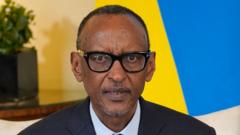The newly announced caretaker government in Syria aims to bridge divides as Ahmed al-Shara takes the helm.
Syria Enters a New Era with Transitional Government

Syria Enters a New Era with Transitional Government
Syrians Met with Mixed Reactions to Newly Formed Leadership
The announcement of a caretaker government in Syria, led by interim president Ahmed al-Shara, unfolded late Saturday as the region processes significant political shifts following years of civil war. The newly formed cabinet is designed to represent the various ethnic minorities within Syria while stabilizing the nation under rebel leadership.
Mr. al-Shara’s government will hold power for the next five years amidst ongoing tensions and a fragile peace. This development follows the December overthrow of President Bashar al-Assad by a coalition of rebels, who have since asserted control over parts of the country. With the swearing-in of 23 ministers, the cabinet composition appears to be a balancing act aiming for inclusivity and continued allegiance to al-Shara.
Of the appointed ministers, seven are allies from the rebel-controlled Idlib, while nine technocrats and former activists join the fold, including five who previously served under the Assad regime. A notable feature is the representation from major ethnic groups, highlighting the appointment of Hind Kabawat as the sole female minister, overseeing the Ministry of Social Affairs.
This transitional government has been shaped under pressure from local civil society and international calls for a broader representation following recent ethnic conflicts in the coastal areas of Syria. Experts underscore that despite some remaining dissatisfaction, there is a glimmer of cautious optimism regarding this government’s ability to reflect a more united Syrian identity and address urgent socio-political challenges.
As representatives from diverse backgrounds frame the new administration, it remains crucial for the leadership to extend its outreach and acknowledge the multifaceted fabric of Syrian society, which has endured significant turmoil throughout the civil conflict.
Muhammad Haj Kadour contributed to this report.
Mr. al-Shara’s government will hold power for the next five years amidst ongoing tensions and a fragile peace. This development follows the December overthrow of President Bashar al-Assad by a coalition of rebels, who have since asserted control over parts of the country. With the swearing-in of 23 ministers, the cabinet composition appears to be a balancing act aiming for inclusivity and continued allegiance to al-Shara.
Of the appointed ministers, seven are allies from the rebel-controlled Idlib, while nine technocrats and former activists join the fold, including five who previously served under the Assad regime. A notable feature is the representation from major ethnic groups, highlighting the appointment of Hind Kabawat as the sole female minister, overseeing the Ministry of Social Affairs.
This transitional government has been shaped under pressure from local civil society and international calls for a broader representation following recent ethnic conflicts in the coastal areas of Syria. Experts underscore that despite some remaining dissatisfaction, there is a glimmer of cautious optimism regarding this government’s ability to reflect a more united Syrian identity and address urgent socio-political challenges.
As representatives from diverse backgrounds frame the new administration, it remains crucial for the leadership to extend its outreach and acknowledge the multifaceted fabric of Syrian society, which has endured significant turmoil throughout the civil conflict.
Muhammad Haj Kadour contributed to this report.



















